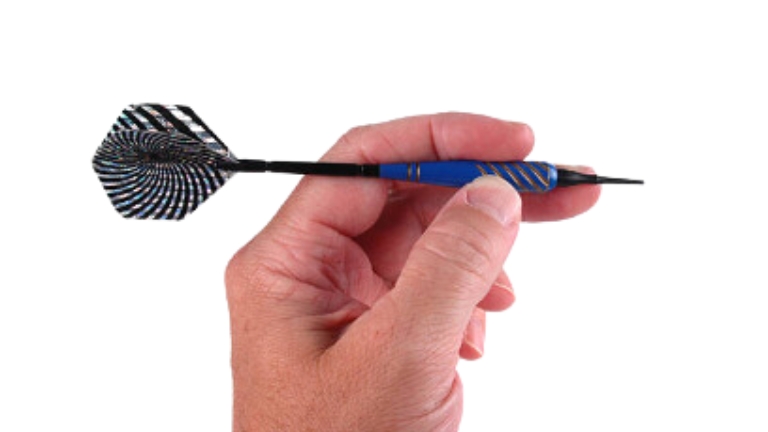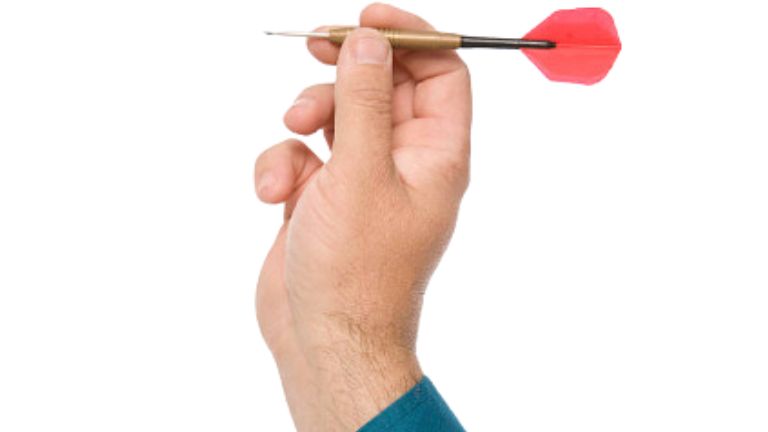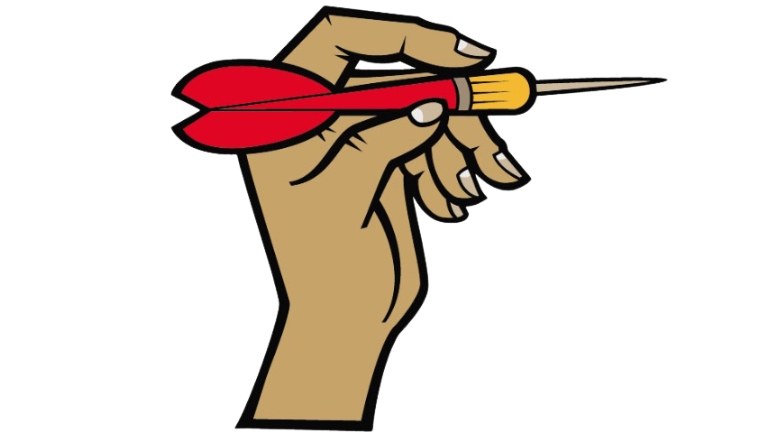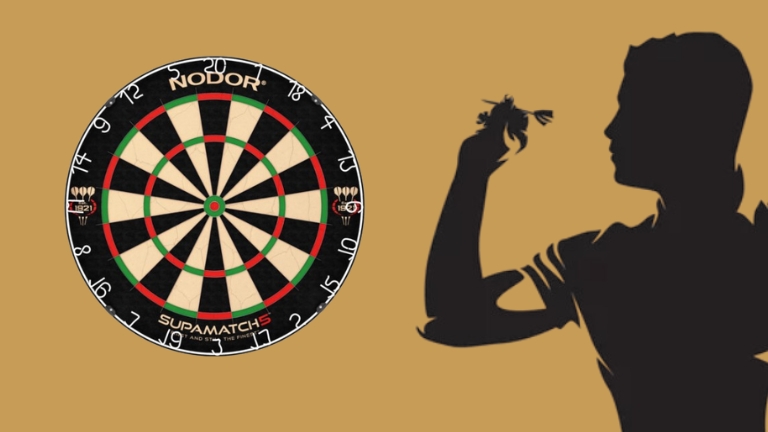Mastering how to accurately hold a dart is the foundation for becoming a skilled darts player. If you’re completely new to darts, the first step is learning how to hold a dart. Even though professional players make it seem easy on television or an online platform, there are some basic principles to consider when you learn how to grip a dart correctly.
This guide is designed to teach you the fundamental aspects of holding a dart and all details are provided to correct your mistakes.
The Components of a Dart
Before diving into the grip, it’s essential to understand the basic components of a dart. A dart typically consists of four parts:
Tip
In darts, the “tip” is the pointed end of the dart that hits the dartboard. This part is typically made of metal or plastic and is meant to go into the board’s surface. The tip is very important because it decides where the dart will land and stick, which affects how many points you get and how accurate you are. A sharp and well-maintained tip makes sure the dart goes firmly into the board, which is important for playing well and getting good results.
Barrel
The barrel in darts is the main and cylindrical section that players grip during a dart throw. It’s usually made of materials like tungsten, steel, or brass, and it affects how heavy and balanced the dart feels. The barrel is designed to provide stability and control, with various shapes and grips to suit different throwing styles. A good barrel helps improve how accurately and consistently a player can throw.
Shaft
In darts, the shaft is the part that joins the barrel to the flight. It’s usually made of materials such as aluminum, plastic, or carbon fiber, and it’s important for how the dart balances and flies through the air. The shaft keeps the dart stable as it flies, affecting how it moves and how accurate it is. There are different sizes and shaft designs, so players can pick the ones that work best for them and feel good when they throw, depending on how they like to play.
Flight
The flight on a dart is the small, wing-like part attached to the back of the dart’s body. It’s basically made of plastic or nylon and helps keep the dart steady as it flies through the air. The shape and size of the flight change how the dart moves and flies, which can affect how well it goes where you want it to. There are many different shapes and styles of flights, so players can pick ones that help them throw their darts more accurately and effectively.
What is the Grip in Darts
In darts, the grip is about how a player holds the dart, which affects how well they can control and aim it. This means where you put your fingers and thumb on the dart, which affects how you throw it and where it goes. Each player might have a different way of gripping, like holding the dart lightly or firmly. Learning the best grip is important for making the dart fly where you want it to and for playing darts better overall.
Types of Dart Grips
In the game of darts, how you hold the dart is very important because it can greatly affect how well you can aim and how steady your throws are. Here are a few common ways how to hold a dart:
The Pencil Grip
The pencil grip is a favorite among expert dart players. In this method, the player holds the dart-like they would hold a pencil. They use their index finger and thumb to hold the dart, and their middle finger supports it from below. This grip helps in releasing the dart accurately and with control, making it perfect for players who want precision and steadiness in their throws.

The 2 Finger Grip
The 2-finger grip in darts involves players holding the dart with their thumb and index finger. This approach lets them release the dart and with control. It minimize on hand-to-dart contact, which means less drag and a faster, smoother throw.
While this can make for a more fluid release and might improve accuracy for some players, it calls for a steady wrist and exact control. People who like to keep things simple often go for this grip, as it helps them throw faster and focus better.
The 3 Finger Grip
The 3 finger grip in darts is a popular method where the dart is held with the thumb, index finger, and middle finger. This grip offers a good mix of control and accuracy, making it possible to throw the dart steadily yet flexibly.
The thumb holds the dart from below, and the index and middle fingers help guide the throw. This grip is preferred by players who want a reliable release, as it aids in keeping a consistent aim and a smooth release, which improves precision.

The 4 Finger Grip
The 4 Finger Grip means holding the dart with your thumb, index finger, middle finger, and ring finger. This way of holding the dart gives you the most control and steadiness, which is great for players who want to be very accurate. Your thumb helps support the dart, and the other three fingers help guide and steady your throw.
Having more fingers touching the dart makes it harder for the dart to slip when you let go. Players who like to throw the dart in a controlled, steady, and accurate way often use the 4 Finger Grip.
The Rear Grip or Power Grip
The rear grip in darts involves holding the dart closer to the back of the barrel, allowing for more controlled wrist action and increased throw leverage. This helps control the wrist movement and gives more power to the throw. It works well for players who like longer barrels because it adds more control and strength.
This grip can improve accuracy by making the release smoother, but it needs good control to stay stable. It’s great for players who want a mix of power and precision, helping them throw consistently.
The Middle Grip
In darts, the middle grip involves placing your fingers in the center of the barrel, which gives you a balanced hold that mixes control and stability. This grip is perfect for players who like a flexible approach, as it lets you use both strength and accuracy by evenly distributing the dart’s weight.
The middle grip helps you release the dart smoothly, lowering the risk of it shaking and improving your aim. It’s a common choice for players who want to make steady, controlled throws with moderate power.
The Front Grip
In darts, the front grip means holding the dart close to the front of the barrel. This helps players have better control over where the dart goes. This grip works well with shorter barrels because it brings the fingers closer to the dart’s pointy end, making it easier to throw straight.
t improves accuracy but might not give as much power, so it’s good for players who care more about hitting the target exactly. The front grip helps keep the throw steady and smooth, which reduces shaking and makes it easier to hit close targets consistently.
Finding Your Ideal Grip
Finding the ideal grip is a matter of personal preference and depends on what feels comfortable for you, the size of your hands, and how you play. Here are some steps to guide you in choosing the right grip from the options available:
Step 1: Begin by experimenting with the different grips mentioned earlier. Focus on the sensation of each grip in your hand and how it influences your throw. Don’t be afraid to make adjustments, such as changing finger placement or the amount of pressure you apply.
Step 2: When you’re trying out different ways to hold the dart, focus on what feels comfortable and gives you good control. A good grip should feel like it’s the natural way to hold the dart and make it easy for you to throw. If you feel like you’re having a hard time with a certain grip, it might not be the best one for you.

Step 3: After you find a grip that feels right, keep practicing it regularly. Doing this will help you remember it easily, so it becomes natural when you play. As you keep practicing, you’ll learn more about how your grip changes your throw and you can make small changes when you need to.
Some Tips on How to Hold a Dart Accurately
No matter which grip style you pick, there are some tips you can use to make your darts hold better:
Relax Your Hand
To “Relax Your Hand” for holding darts, make sure your fingers and wrist are not stiff. Hold the dart gently with your thumb and fingers, not squeezing too hard. A loose grip helps lower stress, making your throw smoother and more natural.
Let the dart sit easily in your hand with little force. This relaxed way helps you release the dart consistently and aim accurately, as a tight grip can cause shaky throws and less accuracy.
Position Your Fingers Correctly
To hold a dart properly, put it comfortably between your thumb and the first two or three fingers, based on what feels right for you. Make sure the dart touches the fleshy part of your fingers, not the tips, for more control.
Your thumb should be under the dart for support, and your index and middle fingers should help guide it. Keep a steady grip without squeezing too hard, so you can release the dart smoothly and throw it accurately.
Use the Right Amount of Force
You should use a strong but not tight grip to hold a dart properly. Don’t squeeze the dart too hard, as this can cause mistakes in your throw. Instead, hold it firmly enough to keep it steady without stopping it from moving freely.
This way, you can let go smoothly and keep your aim accurate. Change the grip depending on how fast and how you throw, making sure the dart stays steady but isn’t held too tightly when you let go.
Mind Your Finger Placement
Make sure you position your fingers correctly when holding a dart to have a steady grip. Put the dart between your thumb and the first two or three fingers, with your thumb supporting it from below. Your index and middle fingers should rest on the dart’s body, giving you control without too much pressure.
Make sure the dart feels comfortable in your hand, so you can throw smoothly. Good finger placement helps improve your aim and makes your throws more consistent, reducing the chance of the dart shaking or going off course.
Practice Your Dart Release
Practicing your release for a darts hold is crucial for accuracy. Concentrate on executing a smooth, controlled release by keeping a steady grip and allowing the dart to slip from your fingers effortlessly. Don’t make abrupt movements or sudden adjustments in pressure.
Repeatedly practice your throw to build muscle memory, guaranteeing that your release is smooth and accurate. A well-honed release contributes to consistent dart paths and enhanced control over where the dart hits, which boosts your overall performance in the game.
Common Mistakes Avoid in Holding Darts
Even if you know the right way how to hold a dart, you might still develop bad habits that can hurt your game. Here are some common mistakes to watch out for:
Gripping Too Tightly
Gripping too tightly can harm your game by making it hard to control, leading to uneven throws, and tiring your hand quickly. To prevent this, hold the dart gently—just tight enough to keep it steady, but not so hard that it stresses your hand. Aim for a soft, easy grip and practice often to get used to it.
Incorrect Finger Placement
Incorrect finger positioning can make your darts less accurate by causing problems with balance and control. Make sure your fingers are in the right place and put your index finger towards the front of the dart, use your middle finger to support your thumb to keep the dart steady. Don’t put your fingers too far back or too close together, as this can make the dart shake and throw inconsistently.
Changing Grips Frequently
Changing grips frequently can mess up your dart game by making your throws inconsistent and affecting how your muscles remember the movement. Stick to one grip to build reliability and accuracy. Changing grips too much can lead to different release points and less control. Find a grip that feels good and works well for you, and practice with it often.
Ignoring Comfort
Each player has a unique grip and hand size. So, what works for one individual might not work for someone else. Trying to copy someone else’s grip without considering your own comfort can be harmful. Find a grip that fits your hand size and feels good for you, and keep using it.
Select Your Darts Stance
The selection of the darts stance is essential for darts playing. If you want to become professional or irregular, you must select your darts stance. Your right stance will comfort you when holding a dart, throwing a dart, and enjoying every moment of the game. In darts, the throw line, also called the oche, is a line on the floor where you should stand to throw the darts.
The official throw line for steel tip darts is 7 feet, 9¼ inches (2.37 meters), while for soft tip darts, it is 8 feet (2.44 meters). Having an oche or a darts mat can be very helpful if you put a new one in your home darts area, so you always know where to stand while playing.
There are three main stances in darts: forward, closed, and open. While there is no definitive correct or incorrect stance, maintaining consistency by using the same stance for each throw is crucial. It is advisable to experiment with various stances until you discover the one that provides you with the greatest comfort.
The Forward Stance
For beginners, the forward stance is an excellent starting point. This stance involves positioning your dominant foot in front (the right foot for right-handed players and the left foot for left-handed players), ensuring that your toe is just over the oche. Most of your weight should be distributed on this foot, and you should lean toward the dartboard while maintaining balance with your other foot.
The closed stance
The closed stance is when the side of your dominant foot is against the throw line. If you are right-handed, it will be the right side of your right foot; if you are left-handed, it will be the left side of your left foot. For extra support, insert your other foot behind you.
The open stance
To create the open stance, place both feet forwards in front of you and against the oche. Because you cannot lean forward in this stance, the dart will be released farther away from the board. Lots of people sometimes called the front stance.
Perfect Your Dart Aim
The second thing to think about when throwing darts is how to aim at the dartboard. Hold the first dart in your throwing hand and raise it to eye level. If you’re right-handed, aim with your right eye; if you’re left-handed, aim with your left eye.
Place the dart beside your eye, ensuring that the elbow of your throwing arm is directed at the dartboard. It’s essential for your shoulder, elbow, and hand to be in alignment, forming a 90-degree angle. Aim the dart at your intended target, and concentrate on it with your dominant eye instead of the dart you are about to throw.
How to hold a dart for beginners?
It’s important to hold the dart securely but not too tightly for beginners. Follow these steps to hold a dart properly:
- Place the dart between your index finger and thumb, letting the middle part of the dart rest in the gap between these two fingers.
- Place your thumb on the side of the dart, and put your index finger a little bit higher than your thumb.
- Use your middle and ring fingers to support the back of the dart, which helps with steadiness and balance.
- Keep your grip loose; holding too tightly can cause stiffness and reduce your accuracy when throwing.
Try holding the dart like this and change your grip if needed to make it feel comfortable and natural for you. As you practice more, you’ll learn a steady and good grip that suits your way of throwing.

Where is the best place to hold a dart?
If you’re just starting with darts, it’s highly recommended to best to hold the dart in the middle of the barrel to have a good grip. Make sure your fingers are straight and don’t grip the dart too tightly; just use enough force to keep it steady.
Is there a wrong way to hold darts?
There isn’t a specific way to hold darts that’s correct or incorrect. However, specialists have come up with some techniques that are very useful. But there are some common mistakes people make when holding a dart, which can affect their accuracy and consistency. The ideal grip can differ for each person, so it’s smart to try different ones and discover which one feels the most comfortable and works best for you.

